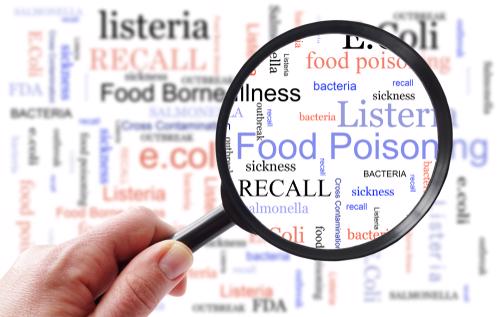The industry needs to keep getting better at food safety.
Transparency and Collaboration are Key to Advancing Food Safety

CPS Team Article
The CDC estimates 48 million people suffer from food borne illnesses each year in the United States—that’s one in six exposed and sickened by food contaminants. Among them, 10,000 are hospitalized and 3,000 die because of the illness.
Statistics like this make it no surprise that food safety is a top priority for anyone involved in food production—everyone from farmers to food manufacturers and regulators, and every other entity within that food value chain.
For a division like Corporate Project Services—and the broader company we’re part of, Wenger Manufacturing—we do not manufacture the food, but we manufacture the equipment and create the processes that do.
Food safety is a top priority for our clients so it’s a priority for us.
In 2011 and in response to several extensive food recalls, the U.S. Food and Drug Administration (FDA) rolled out the new Food Safety Modernization Act (FSMA), the first major federal food safety legislation since 1938, and the only legislation to date that encompassed food for both humans and animals. As a result of this new law, rules surrounding human and animal food safety had some bite for the first time ever, quickly propelling food safety to become a focal point for companies that produce these products.
There is much at stake, not the least of which is the seriously detrimental effect these crises have on a company’s reputation. And in a day when social media can magnify a negative story into a worldwide frenzy in a matter of minutes, there’s no margin for error.
We do need to develop industry-wide best practices for food safety; but finding what is best for today is not an end goal. It must go beyond achieving best-practice level. It’s about continuous improvement.
While food contamination may never be eradicated completely, as an industry our role is to implement methods that ensure contamination is not a direct result of negligence or process errors. We must work constantly to eliminate chances for errors that allow contamination to occur.
We do this because it’s the right thing to do, but these steps also are required for food manufacturers to stay in business. CPS has process know-how to help clients navigate these challenges. Today, food manufacturers must have an effective food safety program in place, so we’re here to support the development of these programs. Global Food Safety Initiative (GFSI) auditors, FDA and USDA inspectors will be onsite conducting checks, so we help clients make sure their programs, practices and procedures are effective in an effort to prepare them for audits.
Food safety should not be a competitive advantage.
In today’s environment, food safety is a complex issue that all companies must address.
There is a critical need for more transparency. In many cases, industry has knowledge and expertise that can enable FDA to better understand how pathogens are controlled via legacy technologies; but competing industry players are naturally resistant to divulging such insight.
We cannot look at safety as a competitive advantage. If we find highly effective processes or technology that keeps food safe, then that knowledge needs to be shared…even though that’s easier said than done.
We have a responsibility as an industry to collaborate and further develop technologies and control measures to keep food safe. Food-borne illnesses are preventable, and we must continue to get better.
Research and industry collaborations have made headways and improvements.
Extrusion, cooking, baking, canning, frying and drying—all are legacy food processing technologies that require scientific validation of each respective processing method today.
Extrusion cooking, being one of these legacy food processing solutions, has proven to be an effective processing tool in manufacturing high capacity, continuous production of food safe pasteurized products via its short-time, high-temperature processing capability. And even though the technology has been used safely for generations, under FSMA it is required that industry be able to scientifically validate the efficacy of this proven technology.
Several companies in our sector came together, including Wenger and CPS, and engaged in collaborative efforts very early in the FSMA development to validate extrusion as a viable technology to produce safe human and animal food. Our company engaged in the opportunity to study and demonstrate the role extrusion technology plays in a food-safe production environment. The only problem was there was no safe way to rigorously study the pathogens involved—you can’t bring pathogens into a live production environment to validate the process.
Through collaboration with the University of Nebraska-Lincoln, which was equipped with biosecurity level 2 (BSL-2) testing capabilities and had extrusion equipment capable of performing validation testing, a cocktail including five (5) strains of salmonella was introduced into a typical pet food recipe and extruded as a means of providing scientific data as to how much heat is required to achieve a desired log reduction of the pathogen, at a given moisture level.
Further testing was undertaken by inoculating a raw material recipe with Enterococcus faecium to further determine the effectiveness of extrusion when inoculating a typical pet food recipe utilizing a surrogate.
Ongoing validation testing involved collaboration with the Institute for Food Safety and Health (IFSH), a food science research consortium that includes the Illinois Institute of Technology, FDA, and members of the food industry. Through this collaborative effort, further testing was undertaken to better understand the efficacy of the extrusion process as a method of controlling pathogens.
These steps provided further scientific evidence confirming extrusion is a viable food processing tool in achieving desired and effective log reduction of pathogens in the food processing environment. A further benefit to these collaborative efforts allowed the FDA to see firsthand the efficacy of extrusion as a food safe pasteurization technology that could be scientifically validated.
Beyond research, another very critical component in creating a safe food environment is effective training and education. Through collaborative efforts with universities, industry partners, and the FDA, more advanced programs are becoming available to train and educate food processing personnel in plant environments—all focused on making a safe food supply. The focus with these programs is not simply to show food processing personnel what to do, but to help them understand WHY these processes are important.
We must continually improve.
Much is being done but there is much more to do. Addressing food safety to protect our food supply and strengthen and sustain public trust will be an ongoing priority requiring collaborative efforts among the regulators, academia and commercial entities along the food supply chain. CPS continues to be an integral part of driving continuous improvement for the industry.
If you’d like to learn about our structured approach to helping clients understand and navigate those ever-developing food safety regulatory requirements, please reach out to our team and we’d be happy to show you more.
Corporate Project Services, a division of Wenger Manufacturing, is a dynamic group of planning specialists backed by Wenger’s more than 80 years of process system supply to the industry. Our knowledge base and breadth of experience in extrusion processing and facilities construction is unsurpassed – and our commitment to excellence is recognized around the world.
More Articles
 Jan 08, 2021
•
10 Minute Read
Communication is Everyone’s Job
When was the last time you did a performance appraisal on your job as a communicator?
Read More
Jan 08, 2021
•
10 Minute Read
Communication is Everyone’s Job
When was the last time you did a performance appraisal on your job as a communicator?
Read More
 Feb 08, 2020
•
10 Minute Read
Boosting Value in a Technical Manual
I can’t say I know anyone who would call an operations manual “riveting” or a “real page turner”—but here at Corporate Project Services we treat these resources as an opportunity to add value for our clients.
Read More
Feb 08, 2020
•
10 Minute Read
Boosting Value in a Technical Manual
I can’t say I know anyone who would call an operations manual “riveting” or a “real page turner”—but here at Corporate Project Services we treat these resources as an opportunity to add value for our clients.
Read More
 Nov 19, 2019
•
10 Minute Read
Navigating the High Stakes and Complexities of Food Manufacturing
Ask anyone involved in food production to name the greatest challenge facing the industry today, and food safety is sure to top the list.
Read More
Nov 19, 2019
•
10 Minute Read
Navigating the High Stakes and Complexities of Food Manufacturing
Ask anyone involved in food production to name the greatest challenge facing the industry today, and food safety is sure to top the list.
Read More